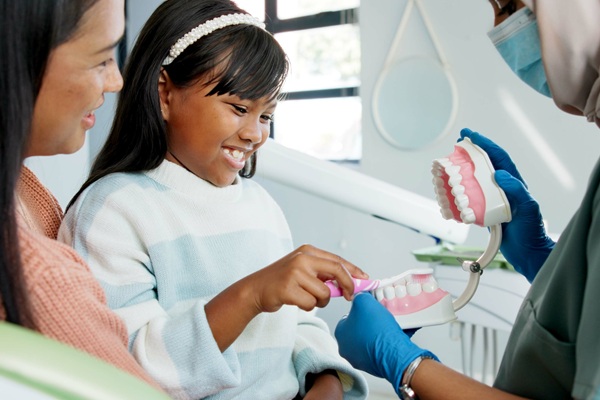Types of Tooth-Colored Crowns

When restoring damaged or decayed teeth in children, pediatric dentists frequently recommend tooth-colored crowns to ensure both durability and aesthetics. Tooth-colored crowns provide a natural appearance, helping young patients feel comfortable and confident while addressing essential dental concerns. Understanding the different types of tooth-colored crowns allows parents to make informed decisions regarding their child's oral health.
Composite resin crowns
Composite resin crowns are a popular option in pediatric dentistry due to their affordability and natural appearance. These tooth-colored crowns closely match the color of natural teeth, making them a discreet restorative choice. Pediatric dentists often recommend composite resin crowns for smaller restorations, particularly on front teeth, because of their aesthetic advantages. Although they offer excellent cosmetic results, these crowns may be less durable compared to other crown materials, especially for teeth subjected to heavy chewing or biting pressures.
Zirconia crowns
Zirconia crowns represent a robust and highly aesthetic choice among tooth-colored crowns. These crowns are made from zirconium oxide and are praised for their superior strength and remarkable durability. Zirconia crowns effectively withstand chewing forces, making them ideal for front and back teeth restorations. Additionally, their stain-resistant qualities help maintain a bright, appealing smile over time. Pediatric dentists frequently select zirconia crowns because they are biocompatible, minimize irritation to surrounding gums and tissues, and ensure comfort for young patients.
Porcelain-fused-to-metal (PFM) crowns
Another reliable option for tooth-colored crowns is porcelain-fused-to-metal (PFM). These crowns feature a metal core covered by porcelain, combining durability with aesthetic appeal. Pediatric dentists may recommend PFM crowns when a tooth requires added strength, particularly in molars subjected to substantial chewing pressure. The porcelain exterior matches the natural color of adjacent teeth, providing a visually appealing restoration. However, in some cases, the metal base might become visible at the gum line over time, slightly affecting the overall aesthetic quality.
Benefits of tooth-colored crowns for children
Tooth-colored crowns provide several key advantages in pediatric dental care, including:
- Natural appearance: Blending seamlessly with surrounding teeth, tooth-colored crowns boost children's confidence in their smiles.
- Durability and functionality: High-quality materials, especially zirconia and PFM, offer the strength necessary for chewing and biting.
- Biocompatibility: Materials used for tooth-colored crowns, such as zirconia and composite resin, typically cause minimal irritation, making them suitable for sensitive gums and tissues.
These crowns allow children to maintain a natural look while receiving protection for long-term oral health. Choosing the right crown supports cosmetic and functional outcomes, helping children eat, speak, and smile easily.
Choosing the Right Tooth-Colored Crowns
Selecting the appropriate type of tooth-colored crowns involves considering factors such as the child's age, the tooth's location, durability requirements, and budget. Pediatric dentists carefully assess these factors, offering tailored recommendations to meet each child's unique dental needs. By partnering with a pediatric dental specialist, parents can ensure their child receives the most suitable restoration for lasting oral health and confidence.
Tooth-colored crowns are essential restorative tools in pediatric dentistry, helping maintain healthy smiles. With careful selection and professional guidance, these crowns support children's oral health effectively and aesthetically. For more information or to schedule a consultation, call Tiny Teeth Pediatric Dentistry at (516) 243-1364.
To schedule a consultation, request an appointment on our website at https://tinyteethpediatricdentistry.com or call Tiny Teeth Pediatric Dentistry at (516) 243-1364 for an appointment in our Mineola office.
Check out what others are saying about our services on Yelp: Read our Yelp reviews.
Related Posts
Pediatric dentistry uses specialized equipment to ensure that children are comfortable during their dental visits. Specialized equipment includes smaller dental chairs, x-ray machines, and age-appropriate educational materials.The dental chair is one of the most significant pieces of equipment in a pediatric dentist's office. These chairs are designed specifically for children and help make the child…
Silver diamine fluoride is a popular minimally invasive technique that is used in dentistry. Specifically, pediatric dentists make use of this type of fluoride because it does not involve any pain or open wounds, both of which children and adolescents tend to fear. With that being said, pediatric patients often have more cavities than the…
When you visit the pediatric dentistry office, the dentist will typically suggest using a soft-bristled toothbrush for children's growing teeth, particularly those under two. A soft-bristled toothbrush is preferable and is gentle when removing plaque and debris, compared to a hard-bristled one, which may irritate gums.Toothbrushes are all about comfiness. When selecting a brush, parents…
If you are concerned about your child's oral health, we encourage you to schedule frequent visits to the pediatric dentistry office. In addition to lowering the risk of cavities, good oral hygiene has been shown to have far-reaching benefits for a child's overall health. They can get the nutrients they need from food and will…
